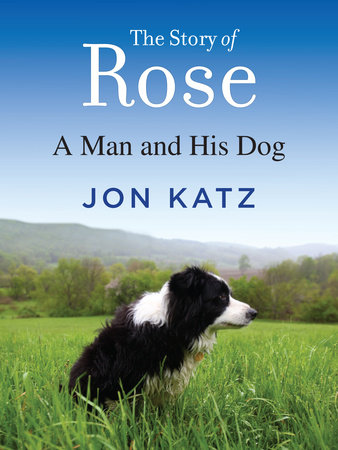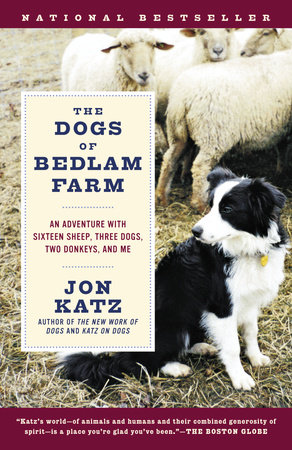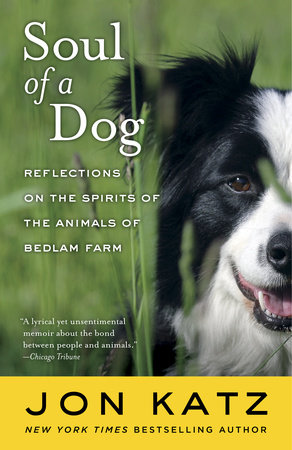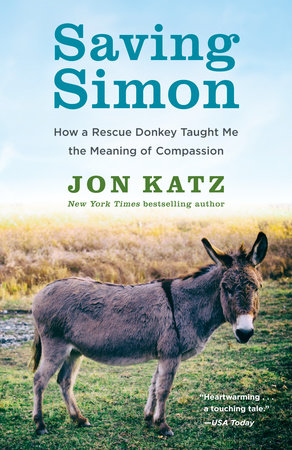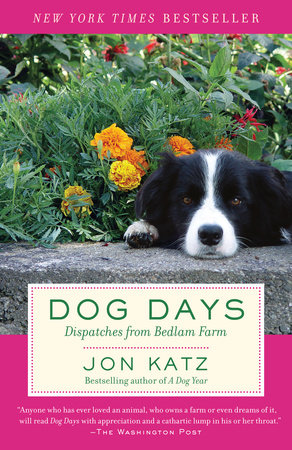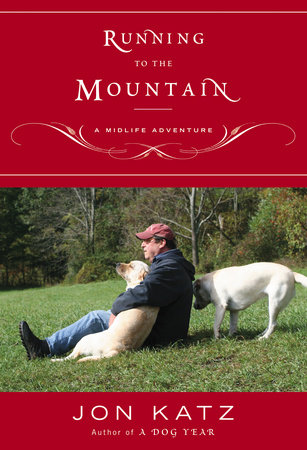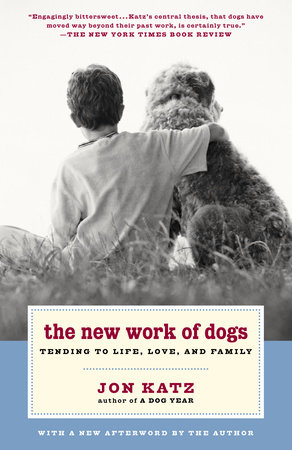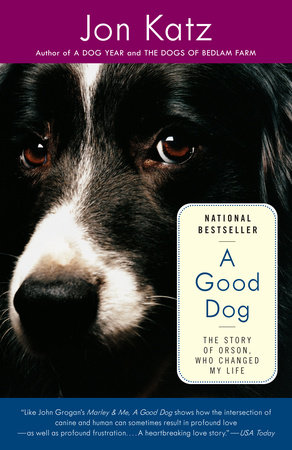A Talk with Jon Katz
1) Your previous book, A Dog Year, was a personal memoir about you and your dogs. Did writing that book lead you to THE NEW WORK OF DOGS?
Definitely. My dogs and I traveled the country for two months after A Dog Year was published. We talked with hundreds of dog owners and lovers, and I was mesmerized at the rich emotional landscape I was seeing between people and their dogs–in part because it reflected what I felt myself. My dogs had changed much of my life–what I wrote about, how I spent my time, how I felt about things. I realized that many books were being published about dogs, but not many were being written about the people who owned dogs, and why we feel so strongly about them.
I saw people giving dogs human names, allowing dogs into their beds, showering them with expensive treats, and attributing human emotions to them. As one person after another came up to me with pictures of their dogs, living and dead, and talked about how much these animals had meant to them, I kept thinking, “Why is this so? Why do we love our dogs so much? Why are we treating them more and more like members of our family, and less like animals?” My initial research reaffirmed something new and dramatic was happening. The number of dogs had skyrocketed from a few million to 68 million in just a couple of decades. And pet care has become a $30 billion industry. I wanted to know why.
2) What exactly is the thesis of THE NEW WORK OF DOGS?
In an increasingly disaffected and disconnected society, where the extended family has declined, people are mobile, work has become insecure, and many Americans spend hours a day in front of TV or computer screens, Americans are turning to dogs more and more for emotional support. Dogs are helping them through loneliness, divorce, aging–all the anxieties of modern life.
3) So, working breeds (border collies, Siberian huskies, etc.) aren’t performing their traditional jobs anymore?
Some are, and dog sports are thriving, but of course few Americans have access to sheep farms or sledding trails, so while these hobbies are vibrant, they are no longer dog’s primary work. That has become tending to their complicated and increasingly anxious owners. This isn’t always the case, of course. Many dogs are acquired for simple, distinctly non-emotional reasons: security, for example.
4) You discuss attachment theory in THE NEW WORK OF DOGS. How does that fit into pet ownership as you have seen it?
When A Dog Year was published, I was surprised to hear from researchers at the University of Kentucky who pointed out that the book was a classic example of attachment theory (and therapy) at work, that I had obvious attachment issues with my border collie Devon, and vice versa. This surprised me. But it also made perfect sense. Many dog owners, according to psychiatrists at the University, re-work attachment issues through their dogs and other pets. Attachment theory holds simply that the degree to which we did or didn’t attach to our parents in infancy shapes our relationships and sense of security later in life. Attachment theory has become a cornerstone theory of modern psychiatry. Researchers of the University of Kentucky agreed to work with me on THE NEW WORK OF DOGS, helping me analyze the attachment issues at work in the powerful human-animal relationships I was tracking. They had a huge impact on my understanding of the human-animal bond and its growing importance in modern life.
5) Beyond explaining why people love their dogs, why is attachment theory practical or important?
It can help people understand why they feel the way they do about their dogs. For example, why do so many people overfeed their dogs? Why is so hard for many people to train the animals they bring into their homes? Attachment issues often come between people and the proper care of their dogs. Understanding attachment can also help in choosing the right dog.
6) Unlike a lot of books and studies that attempt to understand a canine’s thoughts and motivations, you chose to look at the thoughts and motivations of the owners. Why is that?
There’s a million books about training and understanding dogs, but only a handful about the people who own them. To me, that was the opportunity, the untold half of the story. I am not a dog trainer (though technically I became one to research the book). What drew me were the motivations and feelings of the people who felt so strongly about their dogs and were relying on them through critical transitions in their lives–from terminal illness to adolescent isolation to divorce. I felt this use of dogs mirrors the nature of our increasingly edgy, lonely and fragmented country.
I was also struck at the haphazard way people acquire dogs. Sometimes it’s for kids who love puppies but are overwhelmed by grown-up dogs. Sometimes it’s at malls from disreputable breeders. Americans love the idea of the cute puppy, but often struggle to deal with the grown-up aftermath.
7) You interviewed hundreds of people and met scores of dogs. How did you narrow down which stories to include in the book?
I wanted a mix of funny, powerful and revealing stories, tales that showed rather than told the points I was trying to make. So there are men and women, adults and kids, a range of different kinds of people. Each story has a different point to make about the growing range of ways in which dogs are being used to help humans with their emotional lives.
And by extension, are our expectations of them so unreal as to contribute to the epidemic abuse and abandonment? Up to 10 million dogs a year are put into the shelter system, many to be killed. Why do we rescue dogs but not people?
I was also awestruck at the hard work dogs are doing across the spectrum of human behavior to help their owners out. One thing I learned from my year exploring Montclair, NJ, the town I call “Dogville, U.S.A.” is that, increasingly, all dogs are working dogs.
8) That brings up an interesting point. Why did you limit your examples to this one New Jersey suburb?
Researching the demographics of dog ownership in America provided by the U.S. Veterinary Association I realized that my own town very closely reflects national trends in dog ownership in terms of income, gender, age, race and ethnicity. Montclair, New Jersey, mirrors the U.S. almost exactly when it comes to dog ownership.
9) I have to ask–what has become of "The Divorced Dog Club"?
They have scattered, as I explain in the epilogue, but are all doing well in their new relationships. All credit their dogs with helping them get through some tough times. I really came to admire these women, who turned to dogs for critical support in their lives while keeping sight of the fact that these companions were dogs, not people. They did not want nor expect their pets to replace human companionship.
10) Your profile of Betty Jean, who has rescued more than 500 dogs is particularly moving. How long have rescue groups like this one been around and has the Internet helped them grow?
The Internet has spawned a phenomenal explosion of the dog rescue movement. A decade ago, people went to their local shelters to look for a dog in need of a home. Now, they can go onto one or two nationally-linked websites and look at pictures of hundreds of thousands of dogs in need of new homes. Dogs are being transported all across the country now, and digital pictures are an integral part of the dog adoption process. Dog rescue groups are broken down by geography as well as breed. The Net has turned the dog rescue movement into a vast, linked, rapidly growing, all-volunteer, highly effective network. About 10 million dogs are believed to be in the U.S. shelter system at any given time, according to the U.S. Humane Society. Of those, about half will be euthanized.
11) THE NEW WORK OF DOGS seems, in a subtle way, to be an argument for less stringent leash laws and more stringent training laws. How do you feel about dog training?
I guess it isn’t that subtle. My experience writing THE NEW WORK OF DOGS has left me with a strong conviction that people need to train their dogs in order to have the dogs they need and will want to keep–dogs that can co-exist happily with other humans and dogs. I believe what almost all the trainers say: almost any dog can be calm, loving and responsive if trained properly.
I’d love to see more training laws and fewer leash laws, although I don’t think either is really all that feasible for most of the country. We have more dogs than ever, but people are busy and distracted. Americans love cute puppies, but we don’t love what is often the aftermath–dogs that dump in the house, fight with other dogs, jump on people or chew furniture.
Few dogs are trained, and they are increasingly being segregated from the general population as town after town bans the unleashing of dogs anywhere. This may or may not be good for humans, but it’s a disaster for dogs. They were literally born to run. Even though there are tens of millions of dogs, they are being deprived of the opportunity to mix freely with humans and dogs, which can lead to neurotic and aggressive behavior, thus more laws and restrictions. It’s a civic morass in a way, one nobody is thinking through very clearly and intelligently. We need to also work hard to remember, I think, that dogs are animals, not people. They don’t think like people nor react like people. I think a lot of people are losing sight of that.
12) What’s next for Jon Katz?
I have been struck by the fact that the dog world is increasingly dominated by women. Most new vets are women, as are most breeders and trainers. And more than 80 per cent of the primary caretakers of dogs are women. This reality is very recent, reflecting radical changes in the dog culture, and very interesting. In THE NEW WORK OF DOGS, I set out to find out why Americans are turning to dogs for emotional support. In my next book, tentatively titled Women and Dogs, I want to find out why women and dogs are becoming so deeply enmeshed.
